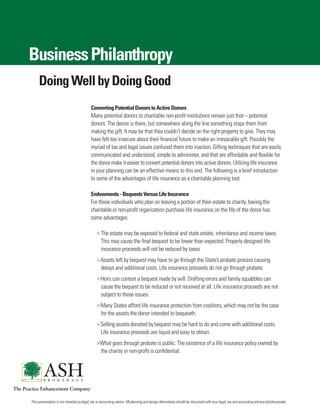
Li Charitable Giving Charity
- 1. Business Philanthropy Doing Well by Doing Good Converting Potential Donors to Active Donors Many potential donors to charitable non-profit institutions remain just that – potential donors. The desire is there, but somewhere along the line something stops them from making the gift. It may be that they couldn’t decide on the right property to give. They may have felt too insecure about their financial future to make an irrevocable gift. Possibly the myriad of tax and legal issues confused them into inaction. Gifting techniques that are easily communicated and understood, simple to administer, and that are affordable and flexible for the donor make it easier to convert potential donors into active donors. Utilizing life insurance in your planning can be an effective means to this end. The following is a brief introduction to some of the advantages of life insurance as a charitable planning tool. Endowments - Bequests Versus Life Insurance For those individuals who plan on leaving a portion of their estate to charity, having the charitable or non-profit organization purchase life insurance on the life of the donor has some advantages. > The estate may be exposed to federal and state estate, inheritance and income taxes. This may cause the final bequest to be lower than expected. Properly designed life insurance proceeds will not be reduced by taxes. > Assets left by bequest may have to go through the State’s probate process causing delays and additional costs. Life insurance proceeds do not go through probate. > Heirs can contest a bequest made by will. Drafting errors and family squabbles can cause the bequest to be reduced or not received at all. Life insurance proceeds are not subject to these issues. > Many States afford life insurance protection from creditors, which may not be the case for the assets the donor intended to bequeath. > Selling assets donated by bequest may be hard to do and come with additional costs. Life insurance proceeds are liquid and easy to obtain. >What goes through probate is public. The existence of a life insurance policy owned by the charity or non-profit is confidential. This presentation is not intended as legal, tax or accounting advice. All planning and design alternatives should be discussed with your legal, tax and accounting advisors/professionals.
- 2. Leveraging a Charitable Gift with Life Insurance Often times a potential donor’s desire to make a charitable gift exceeds their financial capacity to do so. They feel good about what can be accomplished with the funds and have a strong relationship with the charitable organization, but they feel that making a substantial irrevocable gift at this time is beyond their means. Using life insurance as a charitable giving tool may be the answer. There are a number of ways in which life insurance can create substantial charitable gifts with minimal outlay by the donor: Gift of an existing paid-up life insurance contract At one point in their life it was prudent to purchase a life insurance policy to protect the financial interests of their family. If the need for that policy is no longer there it may be donated to charity. At the death of the insured the insurance proceeds will be made payable to the charity. There are also tax advantages that may be realized which can actually make the transaction positive from a cash flow standpoint. Gift of premiums There are a number of advantages that a charitable organization receives from purchasing life insurance on a donor’s life. If making a substantial gift today is beyond a potential donor’s financial means, making smaller annual donations that the charitable organization can use to pay insurance premiums is a good way to leverage their gifts into a much larger contribution. Naming a charity as beneficiary If the idea of leveraging smaller annual contributions into a larger substantial gift is of interest to the donor but they would like to retain ownership of the policy - purchasing a life insurance policy may be an appropriate solution. The donor owns the policy, makes annual premium payments, and names a charity as the beneficiary. Cash value life insurance policies are often used as tax-advantaged accumulation vehicles for those looking to create supplemental retirement income for themselves. The donor can utilize a cash value policy to create retirement income and name a charity as beneficiary thus generating a substantial gift upon their death. This presentation is not intended as legal, tax or accounting advice. All planning and design alternatives should be discussed with your legal, tax and accounting advisors/professionals.
